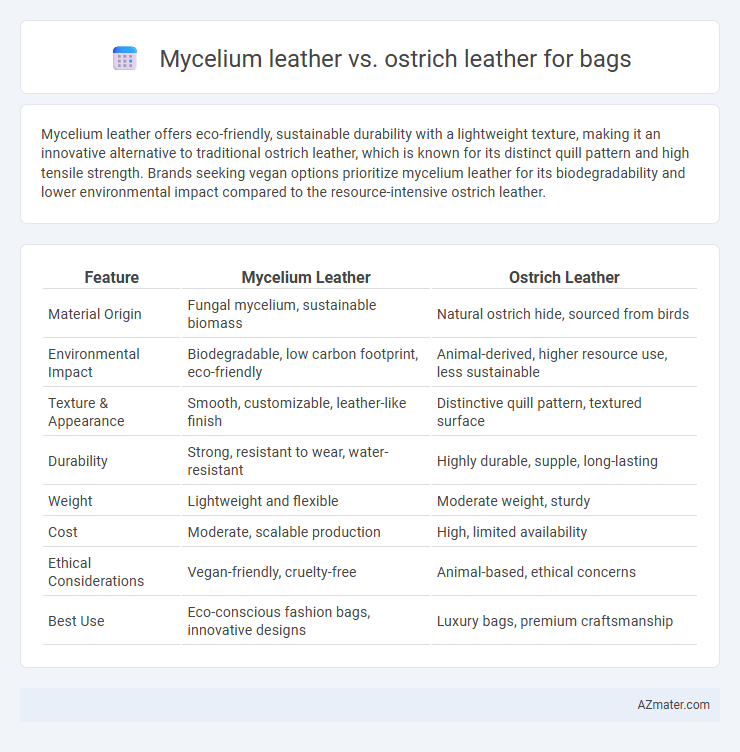Mycelium leather offers eco-friendly, sustainable durability with a lightweight texture, making it an innovative alternative to traditional ostrich leather, which is known for its distinct quill pattern and high tensile strength. Brands seeking vegan options prioritize mycelium leather for its biodegradability and lower environmental impact compared to the resource-intensive ostrich leather.
Table of Comparison
| Feature | Mycelium Leather | Ostrich Leather |
|---|---|---|
| Material Origin | Fungal mycelium, sustainable biomass | Natural ostrich hide, sourced from birds |
| Environmental Impact | Biodegradable, low carbon footprint, eco-friendly | Animal-derived, higher resource use, less sustainable |
| Texture & Appearance | Smooth, customizable, leather-like finish | Distinctive quill pattern, textured surface |
| Durability | Strong, resistant to wear, water-resistant | Highly durable, supple, long-lasting |
| Weight | Lightweight and flexible | Moderate weight, sturdy |
| Cost | Moderate, scalable production | High, limited availability |
| Ethical Considerations | Vegan-friendly, cruelty-free | Animal-based, ethical concerns |
| Best Use | Eco-conscious fashion bags, innovative designs | Luxury bags, premium craftsmanship |
Introduction to Mycelium Leather and Ostrich Leather
Mycelium leather, derived from the root structure of mushrooms, offers a sustainable, biodegradable alternative to traditional animal hides, featuring a soft yet durable texture ideal for eco-conscious bag manufacturing. Ostrich leather, renowned for its distinctive quill pattern and exceptional strength, has long been prized for luxury handbags due to its high durability, flexibility, and unique aesthetic. Comparing Mycelium leather to Ostrich leather highlights the growing shift toward innovative, plant-based materials while maintaining the premium qualities demanded in high-end bag production.
Origins and Production Processes
Mycelium leather is derived from fungal mycelium, cultivated through a controlled fermentation process that uses agricultural waste, making it a sustainable, biodegradable alternative. Ostrich leather originates from the skin of ostriches, primarily processed through traditional tanning methods that involve chemical treatments and labor-intensive procedures. The mycelium production process emphasizes eco-friendly innovation and rapid growth cycles, whereas ostrich leather relies on animal farming and extensive resource use.
Physical Properties and Appearance
Mycelium leather offers a lightweight, flexible texture with a suede-like finish, making it both breathable and eco-friendly, while ostrich leather is renowned for its natural quill pattern, providing a distinctive, luxurious appearance and exceptional durability. Mycelium leather exhibits high tensile strength and water resistance due to its dense fibrous network, whereas ostrich leather features unique raised follicles that enhance softness and elasticity but require more maintenance. The matte, uniform look of mycelium contrasts with the glossy, patterned surface of ostrich leather, influencing the overall aesthetic and tactile experience of bags made from these materials.
Durability and Longevity
Mycelium leather offers eco-friendly durability with natural resistance to wear and tear, making it a sustainable choice for bags. Ostrich leather is renowned for its exceptional toughness and flexibility, featuring unique quill patterns that enhance longevity and resist cracking over time. Both materials provide remarkable durability, but ostrich leather traditionally outperforms mycelium in lifespan under heavy use.
Environmental Impact and Sustainability
Mycelium leather, derived from fungal mycelium, offers a significantly lower environmental footprint compared to ostrich leather, as it requires minimal water, no animal farming, and produces fewer greenhouse gases. Ostrich leather, sourced from the skins of farmed ostriches, involves high resource consumption including large land use, water, and chemical-intensive tanning processes that contribute to pollution. Choosing mycelium leather supports sustainable fashion by reducing deforestation, animal cruelty, and carbon emissions associated with traditional exotic leathers.
Ethical Considerations in Material Sourcing
Mycelium leather offers a sustainable alternative to traditional materials by utilizing fungal roots that require minimal water, no pesticides, and can be grown rapidly in controlled environments, significantly reducing environmental impact. Ostrich leather, while durable and luxurious, involves animal farming which raises ethical concerns related to animal welfare, including living conditions and slaughter practices. Choosing mycelium leather supports cruelty-free production methods and aligns with growing consumer demand for eco-friendly, ethical fashion products.
Versatility and Design Potential
Mycelium leather offers exceptional versatility with its lightweight, sustainable, and flexible characteristics, allowing designers to experiment with innovative textures and customizable thicknesses. Ostrich leather is prized for its distinctive quill pattern and natural durability, lending a luxurious and exotic appearance ideal for high-end, structured bags. The design potential of mycelium leather emphasizes eco-friendly fashion and adaptability, while ostrich leather excels in classic, premium craftsmanship with a unique visual appeal.
Cost and Market Availability
Mycelium leather offers a cost-effective alternative to ostrich leather, with production expenses significantly lower due to sustainable, lab-grown processes reducing reliance on animal farming. Market availability of mycelium leather is expanding rapidly as demand for eco-friendly materials increases, while ostrich leather remains less accessible and costly, predominantly due to its rarity and traditional tanning methods. Consumers seeking affordable, sustainable bag materials increasingly prefer mycelium leather over the high-priced ostrich leather niche market.
Consumer Perception and Brand Adoption
Mycelium leather is gaining traction among eco-conscious consumers due to its sustainable, cruelty-free production, often perceived as a cutting-edge alternative to traditional materials like ostrich leather, which remains valued for its luxury and distinctive texture. Brands embracing mycelium leather appeal to younger, environmentally aware demographics seeking innovative, plant-based options, while ostrich leather continues to attract consumers prioritizing heritage, durability, and high-end craftsmanship. The adoption of mycelium leather by fashion brands signals a shift towards sustainability without sacrificing premium quality, challenging ostrich leather's dominance in luxury bag markets.
Choosing the Best Leather for Bags
Mycelium leather offers a sustainable and eco-friendly alternative to traditional materials, featuring durability and flexibility suitable for high-quality bags. Ostrich leather is prized for its distinctive quill pattern, exceptional softness, and natural resistance to wear, making it a premium choice for luxury bags. When choosing the best leather for bags, consider factors like environmental impact, texture preferences, longevity, and intended use to match performance with style.

Infographic: Mycelium leather vs Ostrich leather for Bag
 azmater.com
azmater.com